Author: Lucio Chachamovich

-
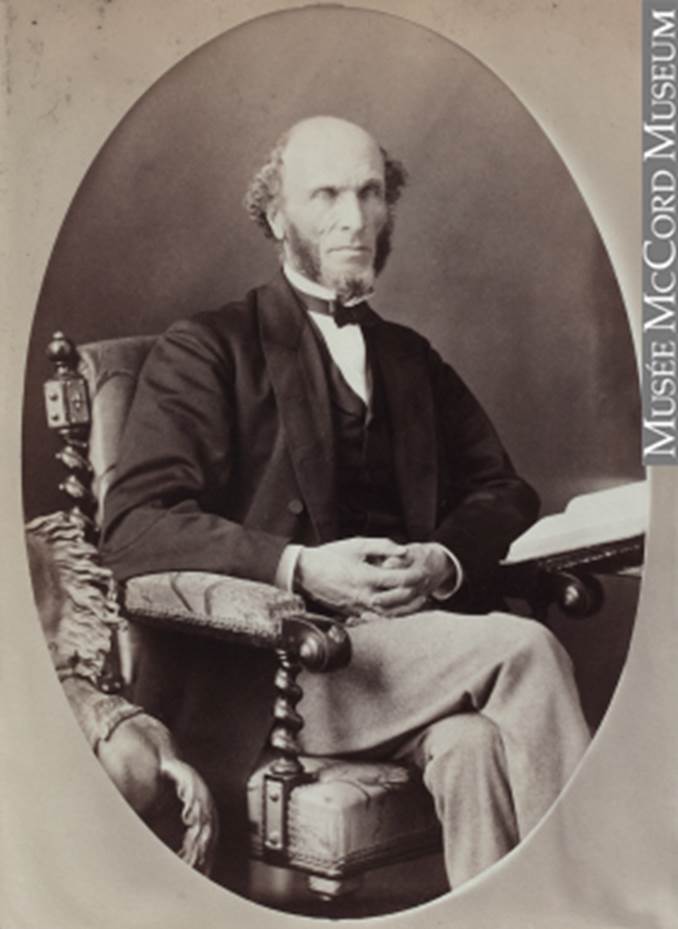 Ezekiel Moses Hart, Montreal, QC, 1874, William Notman (1826-1891). Purchase from Associated Screen News Ltd. II-9169.1.Photo Credit : © McCord Museum, Montréal.
Ezekiel Moses Hart, Montreal, QC, 1874, William Notman (1826-1891). Purchase from Associated Screen News Ltd. II-9169.1.Photo Credit : © McCord Museum, Montréal. -
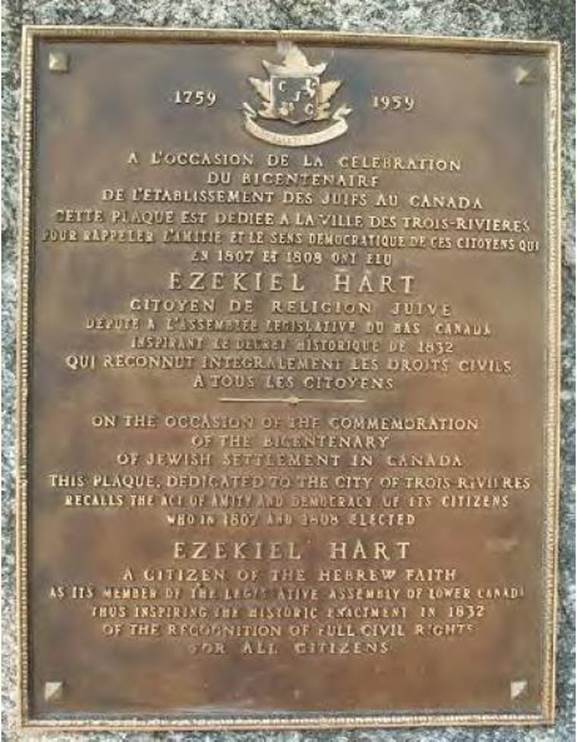 A plaque commemorating Ezekiel Hart in Trois-RivièresPhoto Credit : Daniel Robert
A plaque commemorating Ezekiel Hart in Trois-RivièresPhoto Credit : Daniel Robert -
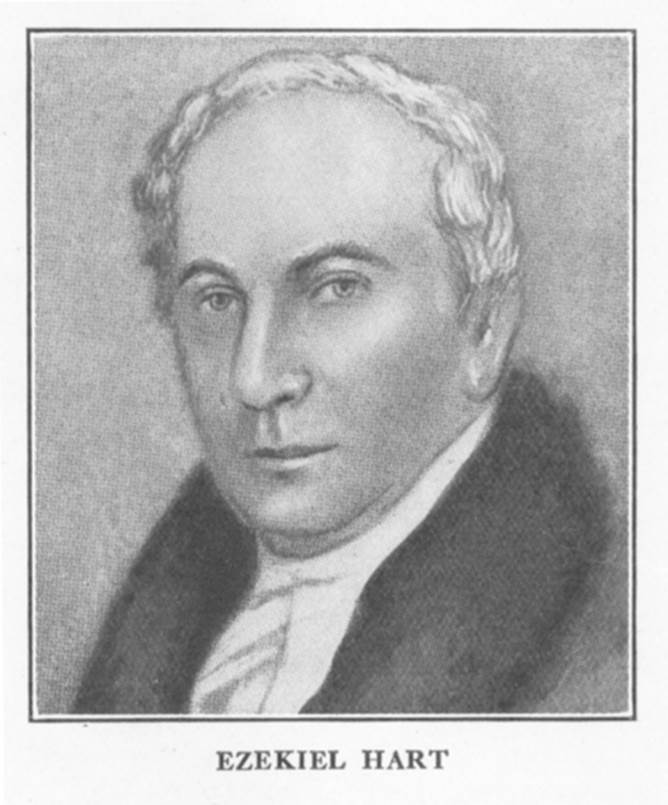 Image pulled from The Jew in Canada.Photo Credit : Jewish Public Library - Archives
Image pulled from The Jew in Canada.Photo Credit : Jewish Public Library - Archives -
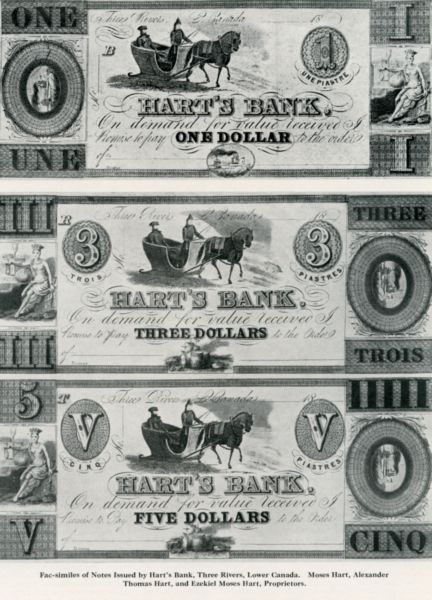 Facsimiles of Notes issued by Hart’s Bank.Photo Credit : Jewish Public Library - Archives
Facsimiles of Notes issued by Hart’s Bank.Photo Credit : Jewish Public Library - Archives -
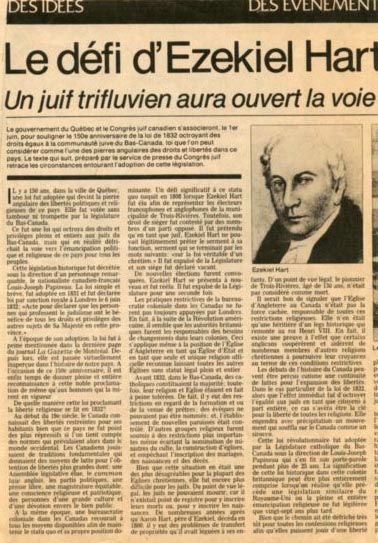 News clipping about Ezekiel Hart, one of the first generation of Jewish Canadians, and the first Jew to be elected to public office in the British Empire.Photo Credit : Jewish Public Library - Archives
News clipping about Ezekiel Hart, one of the first generation of Jewish Canadians, and the first Jew to be elected to public office in the British Empire.Photo Credit : Jewish Public Library - Archives
Ezekiel Hart
Ezekiel (Ezechiel) Hart – son of Canada’s first Jewish settler, Aaron Hart – was an entrepreneur and politician, known for being the first Jew in the British Empire to be elected to political office.
Hart was born and raised in Trois-Rivières. Like his father, he was a prominent merchant. He ran a brewery with his brothers, Moses and Benjamin, and owned a general store. He was also a shareholder at the Bank of Montreal. Hart went on to be elected to the Legislative Assembly of Lower Canada in an1807 by-election. However, when he was being sworn in with the phrase “on the true faith of a Christian,” he substituted the word “Christian” for “Jew,” as was customary for Jews to do in court. Attorney general Jonathan Sewell and runner-up Thomas Coffin argued that this made him ineligible for the House of Assembly, and Hart was prevented from taking office. In 1808, L’Affaire Hart continued when Hart was re-elected, took the Christian oath without alterations, and was expelled once again.
In 1830, Hart’s son, Samuel Bécancour Hart, ran for magistrate of Trois-Rivières and was, like his father, met with strong opposition. However, Speaker of the House Louis-Joseph Papineau—who had voted for Ezekiel Hart’s expulsion in 1809—had a change of heart and was moved to enact the 1832 Act to Grant Equal Rights and Privileges to Persons of the Jewish Religion. This law granted the right to vote (but not eligibility to vote) to Jews equal to Catholics, a quarter century before these rights were granted elsewhere in the British Empire. Samuel Bécancour Hart finally became a magistrate in 1833. In 1837, Ezekiel Hart’s younger brother, Benjamin Hart, became justice of the peace in Montreal, as soon as he was no longer required to take a Christian oath.
Although antagonism towards Jews was undoubtedly a factor in L’Affaire Hart, most historians now stress that anti-Semitism was employed instrumentally, in attempts to shift the balance of power between the English and the French in Quebec.
Ezekiel Hart died in Trois-Rivières in 1843; he is buried in the Shearith Israel synagogue section of Mont Royal cemetery.
Special thanks to the Museum of Jewish Montreal.
Learn More:
http://imjm.ca/location/1176
http://www.cbc.ca/news/canada/montreal/quebec-jewish-beer-hart-family-1.3821868
http://www.biographi.ca/en/bio/hart_ezekiel_7E.html
https://www.historica-dominion.ca/content/heritage-minutes/hart-papineau-0
http://faculty.marianopolis.edu/c.belanger/QuebecHistory/docs/jews/1832act.htm
http://www.assnat.qc.ca/en/deputes/hart-ezekiel-3599/biographie.html
http://www.jewish-history.com/Occident/volume1/nov1843/obituary.html

-
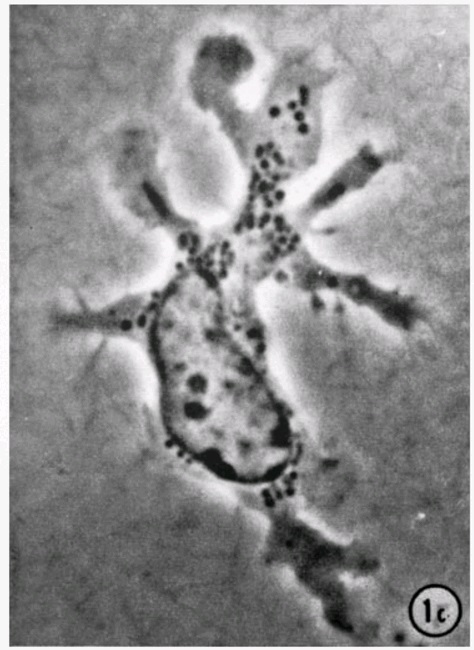 High-resolution image #1 of a dendritic cell made by Dr. Steinman in 1973.Photo Credit : Ralph Steinman/The Rockefeller University
High-resolution image #1 of a dendritic cell made by Dr. Steinman in 1973.Photo Credit : Ralph Steinman/The Rockefeller University -
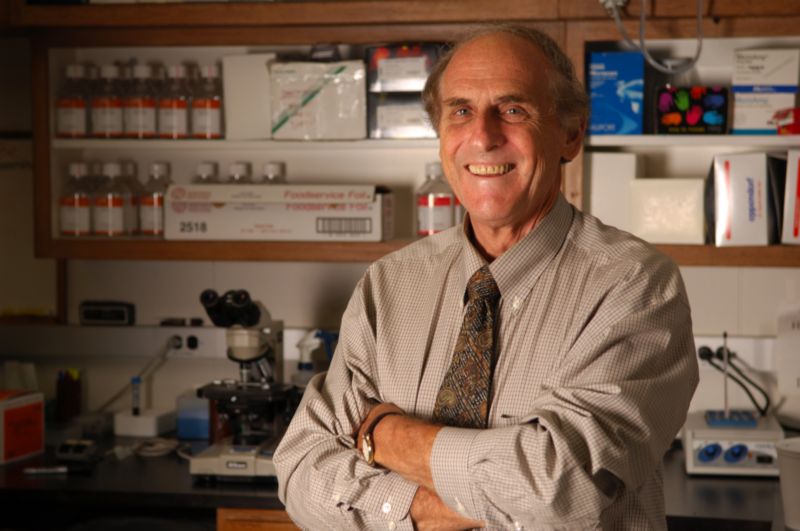 Dr. Ralph Steinman.Photo Credit : The Rockefeller University
Dr. Ralph Steinman.Photo Credit : The Rockefeller University -
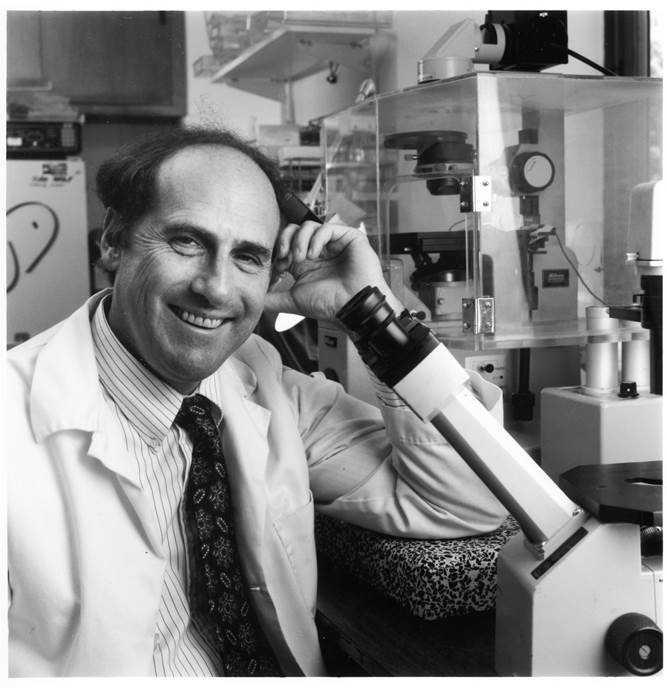 Dr. Ralph Steinman, 1992.Photo Credit : The Rockefeller Archive Center
Dr. Ralph Steinman, 1992.Photo Credit : The Rockefeller Archive Center
Dr. Ralph Steinman
Dr. Ralph Steinman was a medical scientist, and Nobel Prize winner, who discovered dendritic cells.
Born in Montreal, and raised in Sherbrooke, Steinman received a Bachelor of Science from McGill University and his MD magna cum laude from Harvard University Medical School. After a residency at Massachusetts General Hospital, he joined Rockefeller University as a postdoctoral fellow, before being appointed full professor and then being named the Director of the University’s Centre for Immunology and Immune Diseases.
Steinman is best known for his discovery of what he called the dendritic cell (named for its resemblance to the shape of the neural dendrite). His research showed that dendritic cells play a key role in the immune system, a discovery which had wide-reaching implications, especially for chemotherapies. Among other developments, it led to the first therapeutic cancer vaccine, Dendreon’s Provenge, which treats men suffering from advanced prostate cancer.
Steinman’s last experiment was on himself. Diagnosed with Stage IV pancreatic cancer, he offered himself as a subject for experimental cancer treatments, including many based on his own scientific discoveries. In the end, he lived four years longer than predicted.
He died just days before receiving his Nobel Prize, and even though the Committee does not normally proffer posthumous awards, they bestowed this honour upon him even after his death.
Steinman won many awards for his work, including the New York City Mayor’s Award for Excellence in Science and Technology and the Gairdner Foundation International Award. He was also a member of the National Academy of Sciences and the Institute of Medicine.
Learn More:
http://www.reuters.com/article/us-nobel-medicine-experiment-idUSTRE7956CN20111006
http://www.rockefeller.edu/about/awards/nobel/rsteinman#sidebar
https://www.youtube.com/watch?v=xAm3Z5Iy85w
https://www.youtube.com/watch?v=Xl0PY-vqB4k

-
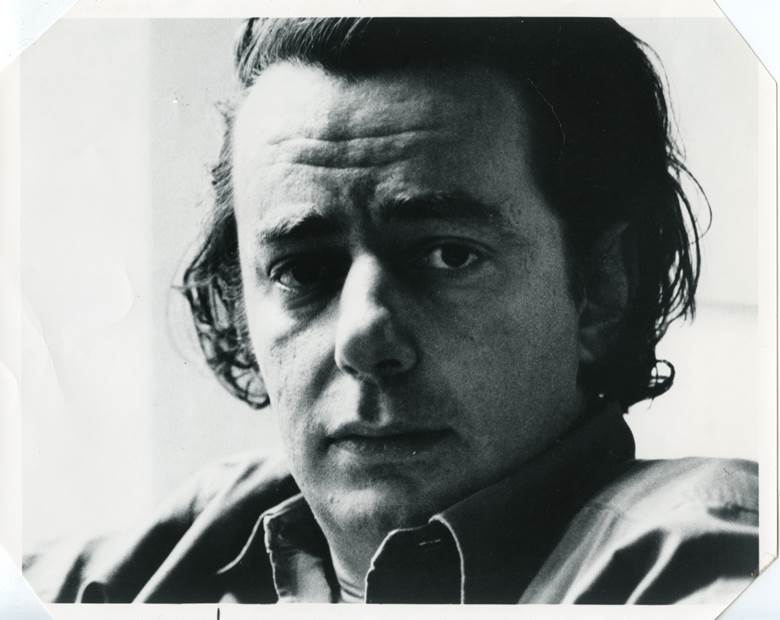 Mordechai Richler - 1970s.Photo Credit : Jewish Public Library Archives
Mordechai Richler - 1970s.Photo Credit : Jewish Public Library Archives -
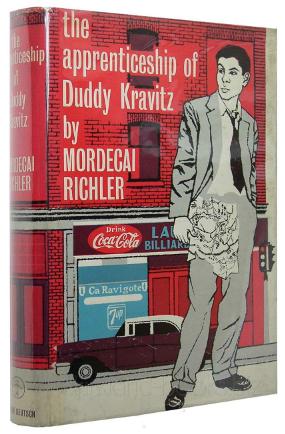 First edition of The Apprenticeship of Duddy Kravitz, one of Richler’s best-known works.Photo Credit : AbeBooks Canada
First edition of The Apprenticeship of Duddy Kravitz, one of Richler’s best-known works.Photo Credit : AbeBooks Canada -
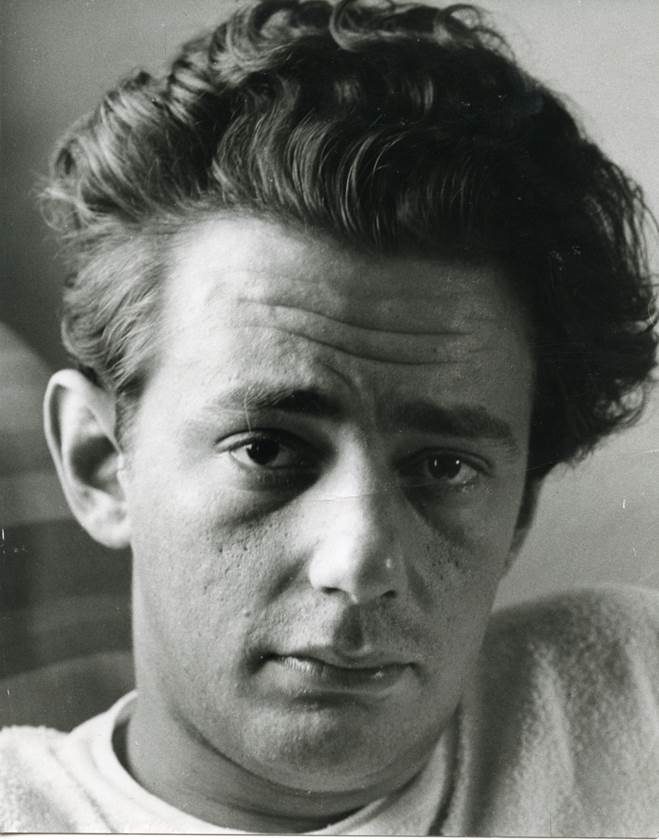 Mordechai Richler –1960s.Photo Credit : Jewish Public Library Archives
Mordechai Richler –1960s.Photo Credit : Jewish Public Library Archives -
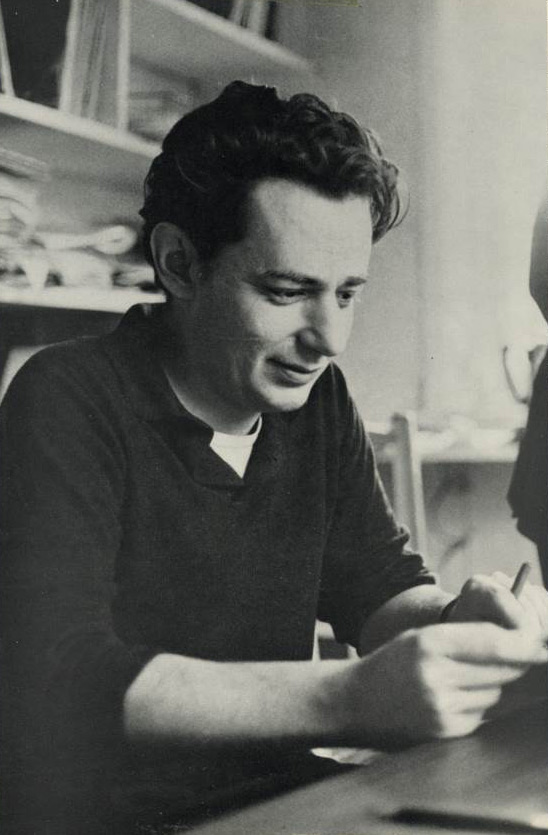 Mordechai Richler – n.d.Photo Credit : Jewish Public Library Archives
Mordechai Richler – n.d.Photo Credit : Jewish Public Library Archives -
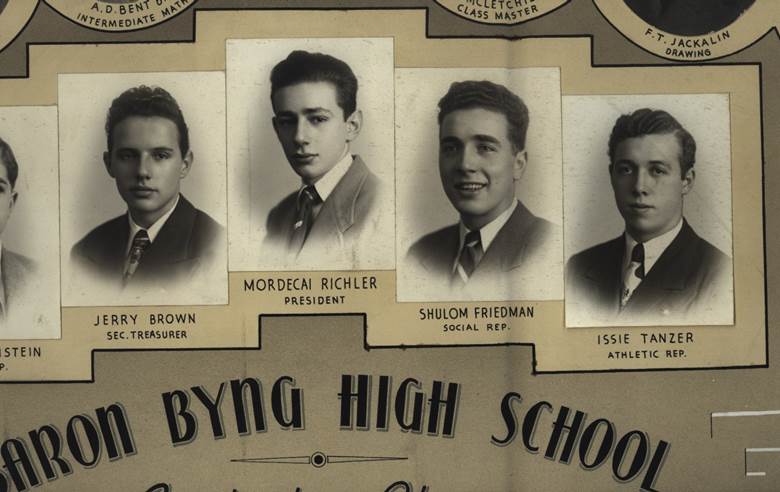 Mordechai Richler as class president at Baron Byng High School (1946).Photo Credit : Alex Dworkin Canadian Jewish Archives
Mordechai Richler as class president at Baron Byng High School (1946).Photo Credit : Alex Dworkin Canadian Jewish Archives -
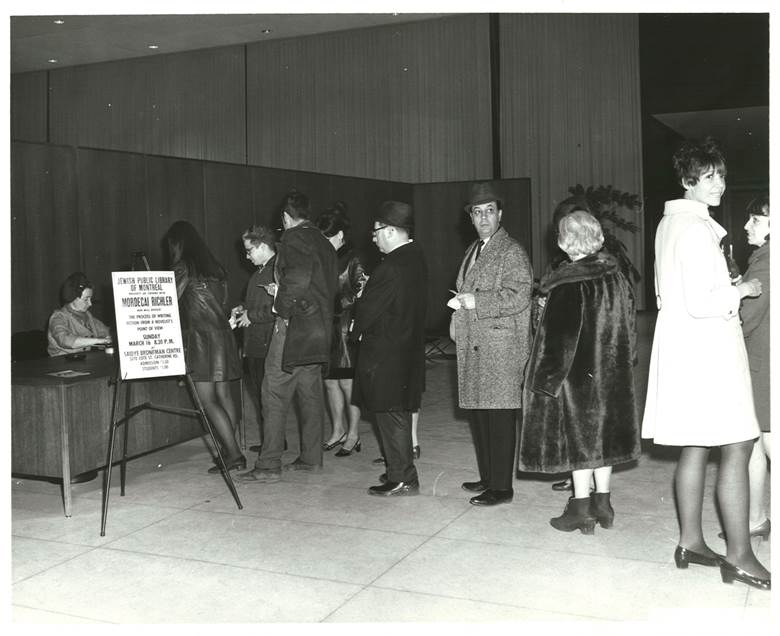 People lining up for tickets at an event with Mordecai Richler, 1969.Photo Credit : the Jewish Public Library Archives
People lining up for tickets at an event with Mordecai Richler, 1969.Photo Credit : the Jewish Public Library Archives -
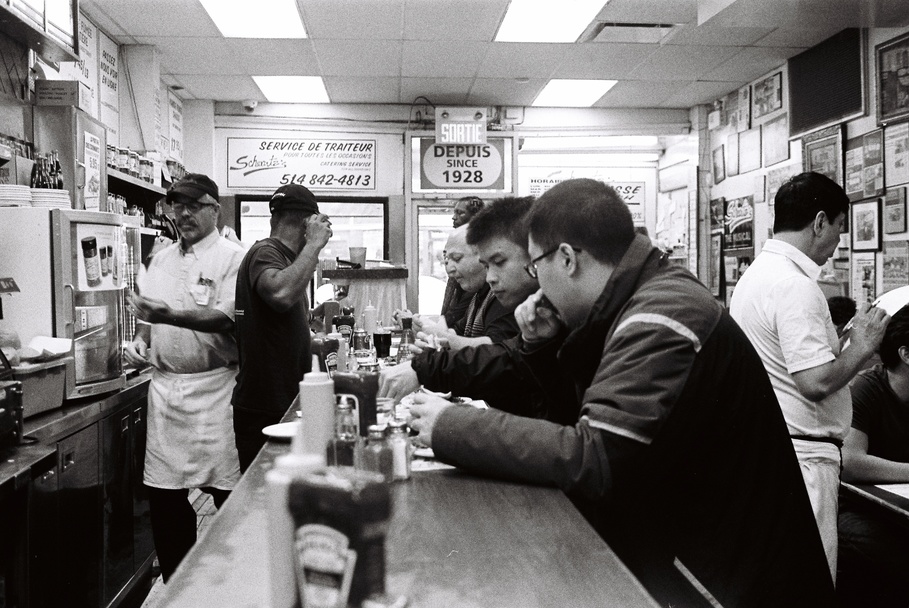 Locations in Montreal referenced in Richler's works.Photo Credit : Oh God! Oh Montreal! Travelling with Mordechai Richler, Andrea Paolella
Locations in Montreal referenced in Richler's works.Photo Credit : Oh God! Oh Montreal! Travelling with Mordechai Richler, Andrea Paolella -
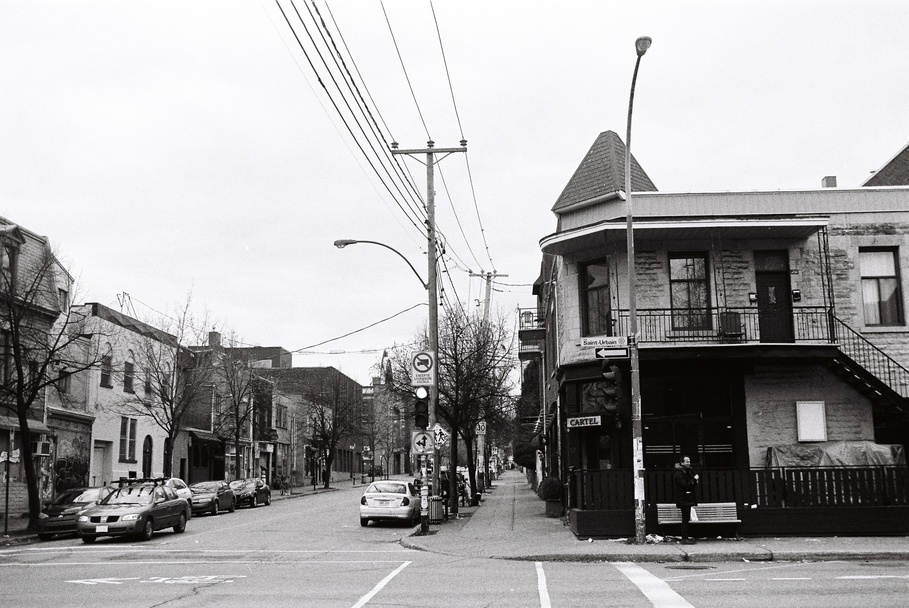 Locations in Montreal referenced in Richler's works.Photo Credit : Oh God! Oh Montreal! Travelling with Mordechai Richler, Andrea Paolella
Locations in Montreal referenced in Richler's works.Photo Credit : Oh God! Oh Montreal! Travelling with Mordechai Richler, Andrea Paolella
Mordecai Richler
Mordecai Richler was an iconic Canadian author who famously, and controversially, explored Quebec separatism and the Montreal Jewish community in his work.
Born a “St. Urbain Street boy” to a poor family in the Montreal Jewish ghetto, Richler’s maternal grandfather was actually an influential religious leader and scholar named Rabbi Yudel Rosenberg, who was born in Poland but moved to Montreal in 1919. There, he became the Chief Rabbi of the United Hebrew Orthodox Congregations of Montreal and was known for translating the Zohar, a classic work of Jewish mysticism, from Aramaic into Hebrew.
Richler’s own status as Montreal’s most famous and celebrated Jewish author is ironic, given his fraught relationship with the community and his often biting portrayal of its idiosyncrasies. In dozens of novels, screenplays, and works of non-fiction, Richler explored what it meant to be a Jew growing up in the tight-knit, isolated, mostly poor, and largely immigrant world along St. Urbain and “the Main.” He also infamously tackled French-Canadian nationalism in books like, Oh Canada! Oh Quebec! Attracting both admiration and criticism, his writings provide an incomparable study of what life was like in his Montreal community, and are a portal through which one can view its unique and dynamic past.
Richler graduated from Baron Byng High School in 1948, where he was president of his class, before dropping out of Sir George Williams College (today’s Concordia University). He briefly lived in France and Spain in the early 1950s and then spent more than 15 years in London, England, before moving back to Montreal in 1972, because he worried “about being so long away from the roots of my discontent.” Richler remained in Montreal, writing and publishing on a variety of subjects, until his death from cancer in 2001.
Richler survives in his widely-read works of fiction, most notably The Apprenticeship of Duddy Kravitz (1959), St. Urbain’s Horseman (1971), Joshua Then and Now (1980), Solomon Gursky Was Here (1989) and Barney’s Version (1997), and in the legacy of the Montreal Jewish community, from which his life and work cannot be disconnected. Richler described and defined the community for Canada and for the world and, whether he liked it or not, the community defined him, too.
A special thanks to the Museum of Jewish Montreal.
Learn More:
http://www.imjm.ca/location/1126
http://www.theglobeandmail.com/news/national/mordecai-richler-gets-his-glory-montreal-renames-library-after-him/article23443003/
http://www.cbc.ca/news/canada/montreal/montreal-to-honour-mordecai-richler-1.1120737

-
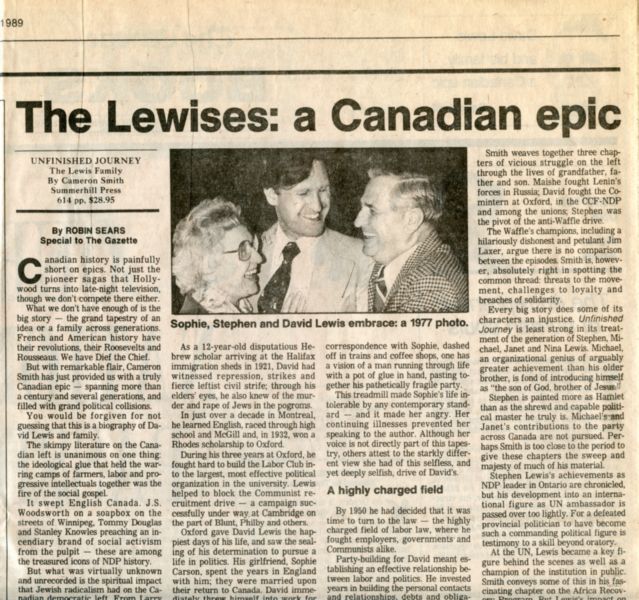 Newspaper clipping from the Montreal Gazette describing the social contributions the Lewis Family has made to Canadian Society (1989).Photo Credit : Jewish Public Library - Archives
Newspaper clipping from the Montreal Gazette describing the social contributions the Lewis Family has made to Canadian Society (1989).Photo Credit : Jewish Public Library - Archives -
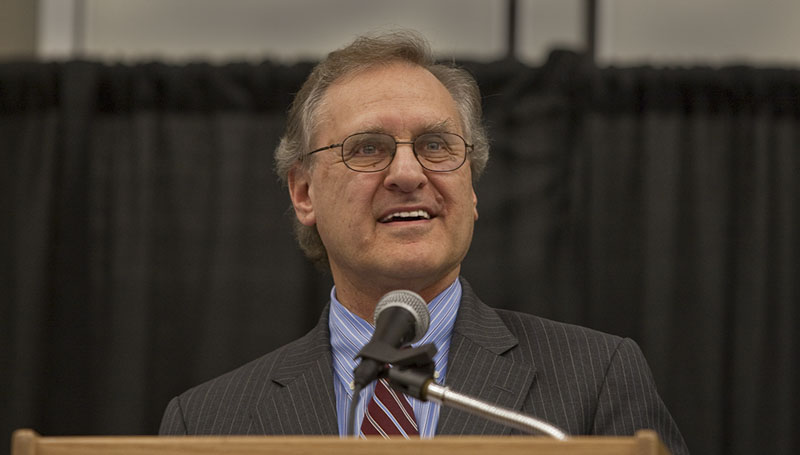 Stephen Lewis speaking at a public event, 2009.Photo Credit : Gordon Griffiths
Stephen Lewis speaking at a public event, 2009.Photo Credit : Gordon Griffiths -
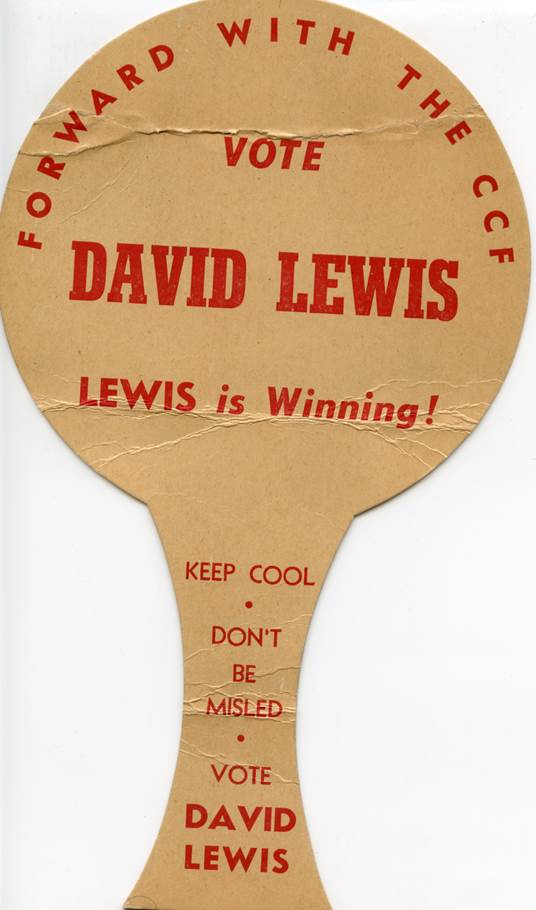 CCF Waving Pamphlet for David Lewis (1950s).Photo Credit : Jewish Public Library - Archives
CCF Waving Pamphlet for David Lewis (1950s).Photo Credit : Jewish Public Library - Archives -
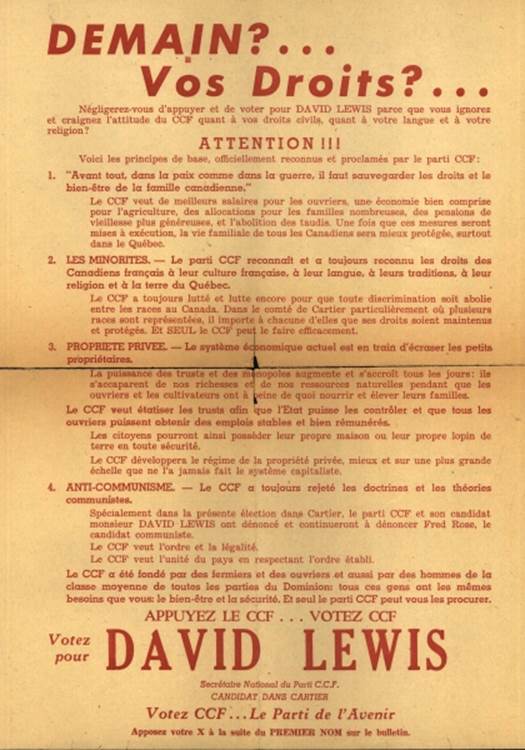 A political poster in support of David Lewis, ca. 1943. Four principles of the CCF are laid out: the rights of the Canadian family, the rights of French-Canadians and other minorities, private property and anti-communism.Photo Credit : Alex Dworkin Canadian Jewish Archives
A political poster in support of David Lewis, ca. 1943. Four principles of the CCF are laid out: the rights of the Canadian family, the rights of French-Canadians and other minorities, private property and anti-communism.Photo Credit : Alex Dworkin Canadian Jewish Archives -
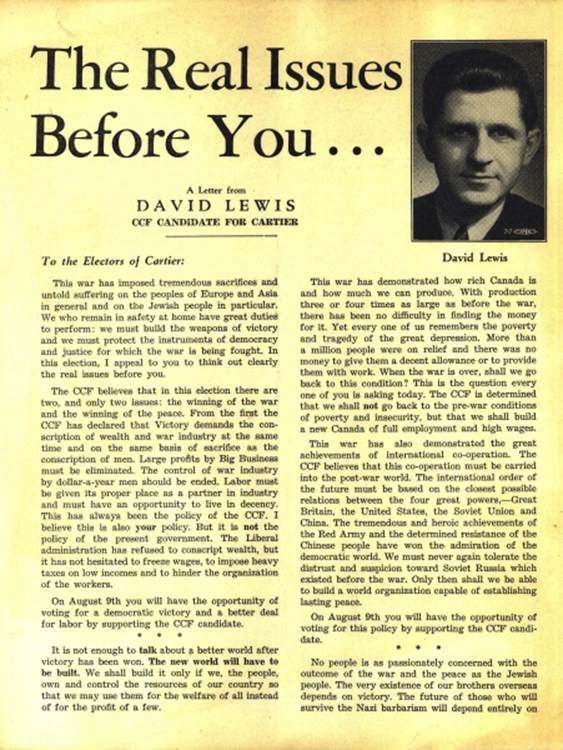 A letter from David Lewis, CCF candidate, to the electors of Cartier Riding, ca. 1943. The letter stresses the need to build a better world after the victory of WWII through a fair distribution of labour, resources and welfare to all. It also celebrates the international cooperation between the four great powers Great Britain, the United States, the Soviet Union and China: “We must never again tolerate the distrust and suspicious toward Soviet Russia that existed before the war.”Photo Credit : Alex Dworkin Canadian Jewish Archives
A letter from David Lewis, CCF candidate, to the electors of Cartier Riding, ca. 1943. The letter stresses the need to build a better world after the victory of WWII through a fair distribution of labour, resources and welfare to all. It also celebrates the international cooperation between the four great powers Great Britain, the United States, the Soviet Union and China: “We must never again tolerate the distrust and suspicious toward Soviet Russia that existed before the war.”Photo Credit : Alex Dworkin Canadian Jewish Archives -
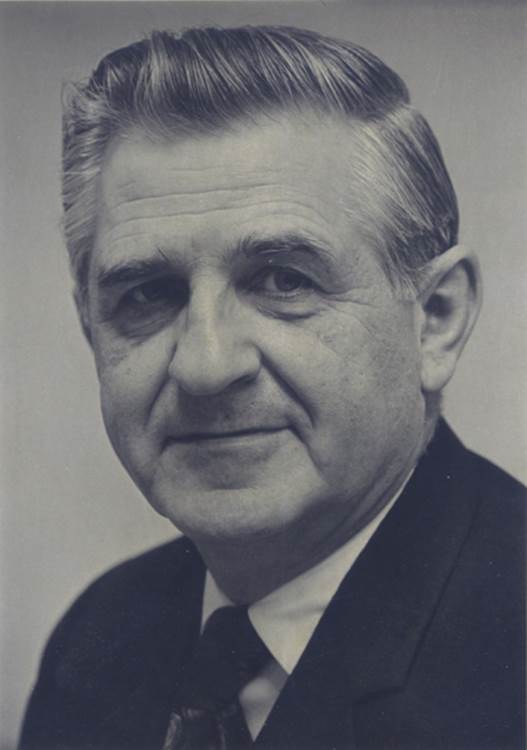 David Lewis, 1973.Photo Credit : Alex Dworkin Canadian Jewish Archives
David Lewis, 1973.Photo Credit : Alex Dworkin Canadian Jewish Archives
The Lewis Family
The Lewis Family is made up of four generations – Moishe, David, Stephen and Avi – who have all devoted their lives to labor and social rights issues.
The grandfather of the Lewis family, Moishe Lewis, was a local Bund leader (Jewish socialist party) in the shtetl of Svisloch (present-day Belarus). After immigrating to Montreal in 1921, he worked in his uncle’s clothing factory. He also continued his labour activism, becoming involved with the Workmen’s Circle, and serving as the Secretary of the Canadian Jewish Labour Committee for many decades. By 1947, Prime Minister Mackenzie King permitted a slight loosening of Canada’s stiff immigration policy, paving the way for the Jewish Labour Committee’s Moishe, along with Kalman Kaplansky and Bernard Shane, to spearhead the Tailors Project. This initiative, part of the 1947 federal bulk labour program, was designed to stimulate the Canadian economy by soliciting skilled labour from European displaced persons, successfully employing Jewish refugees in Canada’s textile industry. For his efforts with labor and civil rights, the Jewish Labour Committee honored Moishe by establishing the Moishe Lewis Foundation in 1975.
Moishe’s son, David Lewis, would follow in his father’s footsteps, leaving an indelible mark on Canadian politics as a labour lawyer and the key architect of Canada’s social democratic Co-operative Commonwealth Federation (CCF) and its successor, the New Democratic Party (NDP). At McGill University, David was sought after as a skilled debater and writer and was one of the first Jewish students awarded the Rhodes Scholarship. Completing his postsecondary studies at Oxford University, he became inspired by Britain’s Labour Party, returning home to implement a Canadian version of social democracy. His bold vision was evident at a scholarship assessment interview with Sir Edward Beatty, the president of the Canadian Pacific Railway (CPR). When asked what his first action would be if elected Prime Minister, he promptly replied, “I’d nationalize the CPR.”
In 1935, David turned down an offer to work in the British Parliament, instead obtaining a law degree in Ottawa, where he became national secretary of the Co-operative Commonwealth Federation (CCF) (1936–1950). His political career attracted attention in 1943 when he lost to his communist competitor, Fred Rose of the Labour Progressive Party, for Montreal’s Cartier riding. David’s work in furthering Canada’s social democratic cause led to correspondence with political leaders and union heads involved in Montreal’s labour struggles. A fierce critic of communism, Lewis relied on his brief experience as a labour lawyer to encourage union members to transfer their support to social democracy. His Make This Your Canada: A Review of C.C.F. History and Policy (1943) was a surprisingly popular history of his party’s policy statements advocating for state control of the economy. Considered more “controversial” than his predecessor, Tommy Douglas, David finally won a seat in Parliament in 1962–1963, and again in 1965–1974, in Toronto’s York South, despite difficulty in convincing the well-off Jews of the district that an atheist who was not a Zionist and had socialist inclinations would represent them well in Parliament.
His commitment to the CCF’s socialist mandate facilitated the emergence of its successor, the New Democratic Party (NDP) in 1961, with Lewis at its head a decade later. The only Jew to lead a national party in Canada, David campaigned against “corporate welfare bums” and paved the way for parliamentary acceptance of acts including affordable housing. After losing the 1974 election, he became a travel correspondent and professor in Ottawa, where he died in 1981.
Stephen Lewis is a Montreal-born politician, diplomat and social activist. Like his father and grandfather before him, he has been a long-standing and loud voice of progress on the left, both nationally and internationally, and is especially known for his work on HIV/AIDS prevention. Stephen served as leader of the Ontario NDP party from 1970 to 1978. He also worked with UNICEF and was Canada’s Ambassador to the UN before he was named UN Special Envoy for HIV/AIDS in Africa from 2001 to 2006.
In 2003, he co-founded and chairs the board of the Stephen Lewis Foundation, designed to fight HIV/AIDS in Africa, and holds professorships at McGill and Ryerson Universities. Stephen has been honoured with 40 doctorates and a myriad of awards including the Order of Canada, the highest honour of the African nation of Lesotho, and Canada’s Queen Elizabeth II Diamond Jubilee Medal, for which he was the first recipient. In 2005, Time Magazine counted him among the 100 most influential people in the world, and in 2012, Macleans called him the Canadian of the Year.
Stephen is married to journalist, author, and social activist Michele Landsberg and is the father of Avi Lewis, spouse of Naomi Klein, both prominent leftist broadcasters and NDP leaders. Michele has written three bestselling books, and was one of the first journalists in Canada to address issues like sexual harassment in the workplace. In 2006, she was made an Officer of the Order of Canada. Stephen’s son Avi has served as MuchMusic’s political specialist, has hosted CBC’s Newsworld’s show counterSpin, and has directed a number of documentaries.
Special thanks to the Museum of Jewish Montreal.
Learn More:
http://imjm.ca/location/1414
http://www.imjm.ca/location/1555
http://www.revparl.ca/9/3/09n3_86e_bournet.pdf
http://www.cjhn.ca/fr/permalink/cjhn277
http://www.dcf.ca/en/scholarships/david_lewis.htm
https://en.wikipedia.org/wiki/Moishe_Lewis
http://www.cbc.ca/player/play/2212119454
http://www.stephenlewisfoundation.org/who-we-are/about-stephen-lewis
King, Joe, and Johanne Schumann. From the Ghetto to the Main: the Story of the Jews of Montreal. Montréal: Montreal Jewish Publication Society, 2000.
King, Joe. Fabled City: the Jews of Montreal . Montreal: Price-Patterson, 2009.
Lewis, David, and F. R. Scott. Make This Your Canada; a Review of C.C.F. “History and Policy,”. Toronto: [Central Canada Pub.], 1943.
Lewis, David. The Good Fight: Political Memoirs 1909-1958 . Toronto, Canada: Macmillan of Canada, 1981.
Smith, Cameron. Unfinished Journey: the Lewis Family . Toronto: Summerhill, 1989.
Tulchinsky, Gerald. Branching Out: the Transformation of the Canadian Jewish Community. Toronto, Canada: Stoddart, 1998.

-
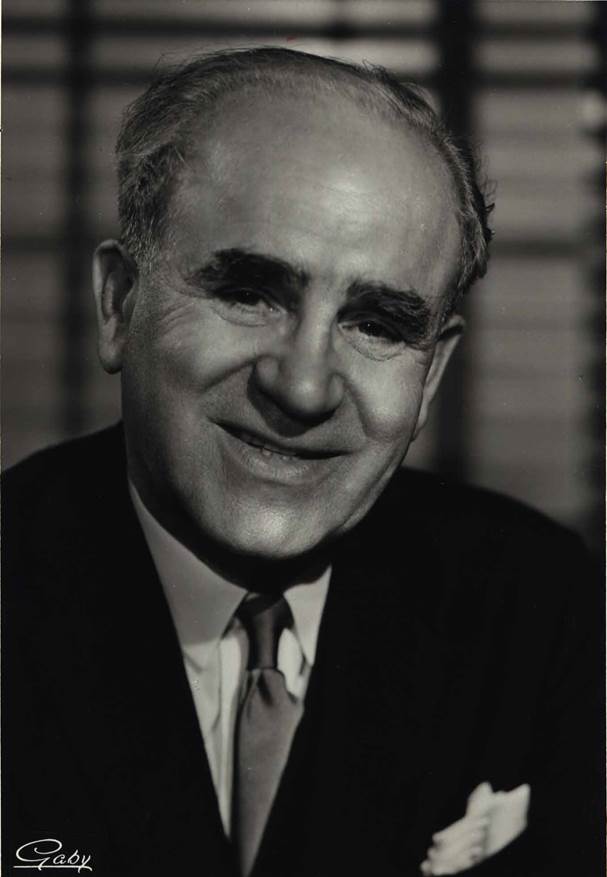 Rabbi Dr. Harry Stern, 1950s.Photo Credit : Alex Dworkin Canadian Jewish Archives
Rabbi Dr. Harry Stern, 1950s.Photo Credit : Alex Dworkin Canadian Jewish Archives -
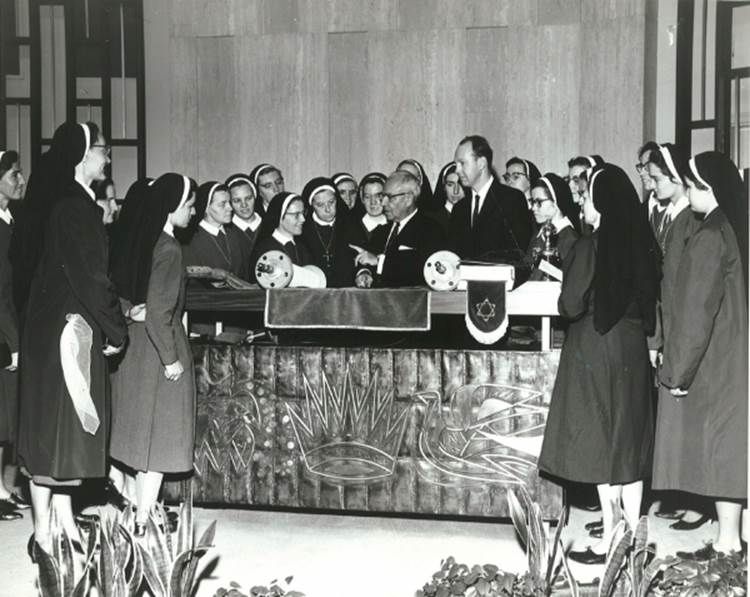 Rabbi Dr. Harry J. Stern explaining the reading of the Torah to a group of nuns from around the world, Temple Emanu-El, Montreal, Quebec, ca. 1960s.Photo Credit : Jewish Public Library - Archives
Rabbi Dr. Harry J. Stern explaining the reading of the Torah to a group of nuns from around the world, Temple Emanu-El, Montreal, Quebec, ca. 1960s.Photo Credit : Jewish Public Library - Archives -
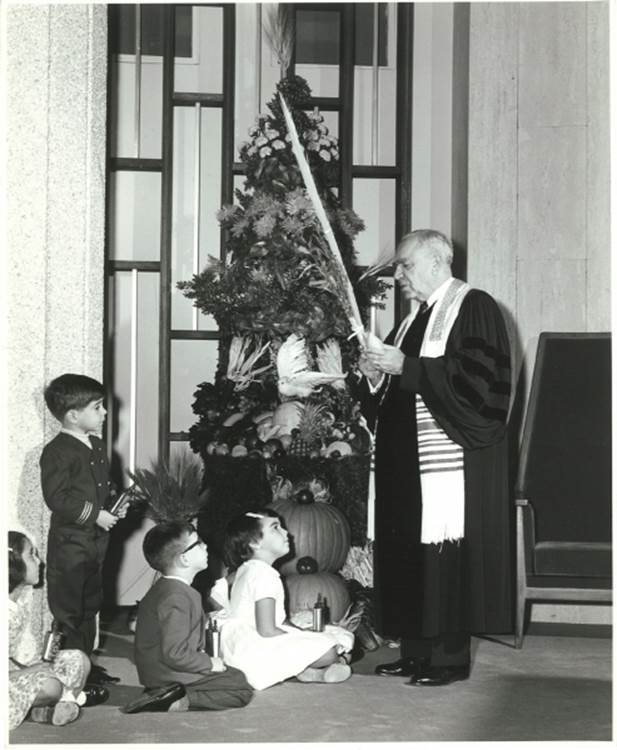 Rabbi Dr. Harry J. Stern holding the branches of a lulav and an etrog (citrus fruit) to celebrate the Jewish holiday of Sukkot, Temple Emanu-El, Montreal, ca. 1950s -1960s.Photo Credit : Jewish Public Library - Archives
Rabbi Dr. Harry J. Stern holding the branches of a lulav and an etrog (citrus fruit) to celebrate the Jewish holiday of Sukkot, Temple Emanu-El, Montreal, ca. 1950s -1960s.Photo Credit : Jewish Public Library - Archives -
 An interfaith Passover Seder with Rabbi Dr. Harry Stern, 1960s.Photo Credit : Jewish Public Library - Archives
An interfaith Passover Seder with Rabbi Dr. Harry Stern, 1960s.Photo Credit : Jewish Public Library - Archives
Harry J. Stern
Born in Eragoly, Lithuania, Rabbi Harry Stern was a fervent Zionist, labour activist, accomplished intellectual and champion of interfaith dialogue.
Following the pogroms of 1905, Stern’s family decided to flee Eastern Europe and immigrate to the US, where they settled in Ohio. In 1927, Stern moved to Montreal to become rabbi of Temple Emanu-El, the city’s first Reform synagogue.
Soon after he arrived in Montreal, a major conflict broke out in the garment industry between workers and their employers, many of whom were members of his own congregation. At the time, more than 32% of the city’s garment workers were Jewish. Stern actively defended their interests in negotiations between the two parties. He rebuked the wealthy manufacturers for their treatment of their “downtowner” brethren, even referring to them as “Jewish anti-Semites.”
Rabbi Stern was also devoted to improving Jewish-Christian relations. He established ties with the Catholic and Protestant clergy and, in 1942, founded the Institute for Clergy and Religious Educators, through which representatives of various faiths exchanged information about their respective religious traditions. In the 1950s and 60s, his annual Fellowship Dinners were created for clerics and laypeople of a variety of faiths to socialize. Indeed, these events were attended by prominent members of the Jewish and non-Jewish communities, including Mayor Jean Drapeau, Cardinal Paul-Émile Léger and even Martin Luther King, Jr. Rabbi Stern was involved in these activities at a time when some Jews denied the legitimacy of Reform Judaism. In 1967, The Rabbi Dr. Harry J. Stern Award was created in his honour, to be conferred upon an individual noted for their significant contribution to interfaith and intercultural dialogue. After his death in 1984, Rabbi Stern’s name was given to a mountain in the Laurentians to commemorate his service to Quebec society.
Rabbi Stern fought against anti-Semitism in the Catholic clergy and in Quebec society, and he publicly denounced Nazism and the atrocities committed against Jews in Europe during the Second World War. A fervent Zionist, he participated in the creation of the Christian Council for Palestine in 1944, a group through which Zionists sought to raise awareness of their cause among the Christian clergy. Rabbi Stern was the Canadian delegate to the first World Jewish Congress in Geneva, in 1936, and served on the Executive Board of the Central Conference of American Rabbis.
Learn More:
http://www.imjm.ca/location/2431
http://www.cjhn.ca/en/permalink/cjhn253
http://www.jewishvirtuallibrary.org/jsource/judaica/ejud_0002_0019_0_19159.html
https://www.templemontreal.ca

-
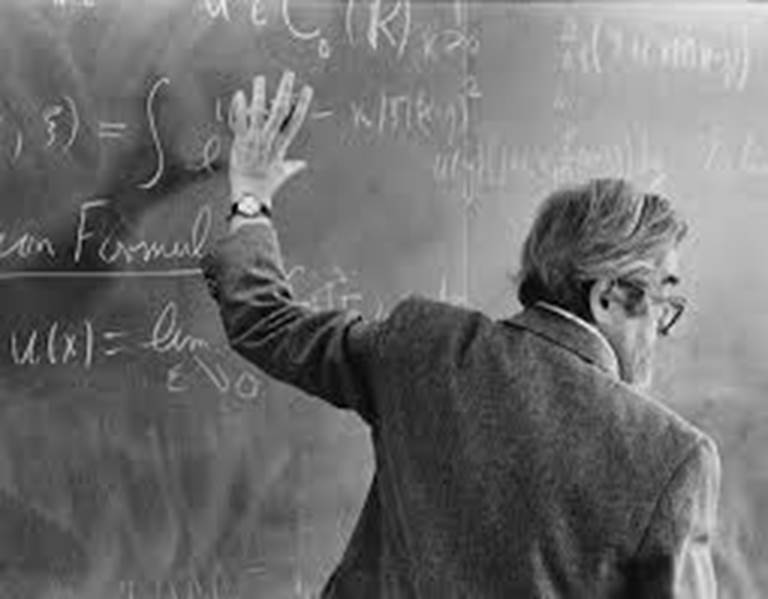 Louis Nirenberg teaching at the Courant Institute of Mathematical Sciences, New York University.Photo Credit : Courant Institute, NYU.
Louis Nirenberg teaching at the Courant Institute of Mathematical Sciences, New York University.Photo Credit : Courant Institute, NYU. -
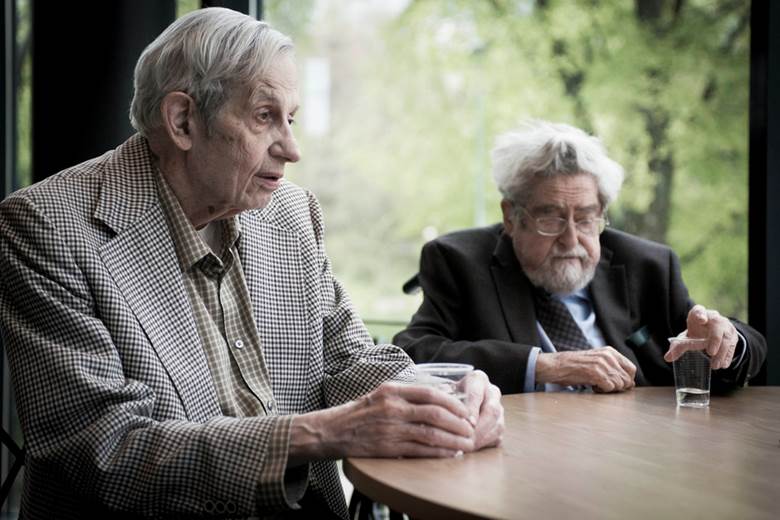 Steven Nash and Louis Nirenberg (2015).Photo Credit : University of Bergen
Steven Nash and Louis Nirenberg (2015).Photo Credit : University of Bergen -
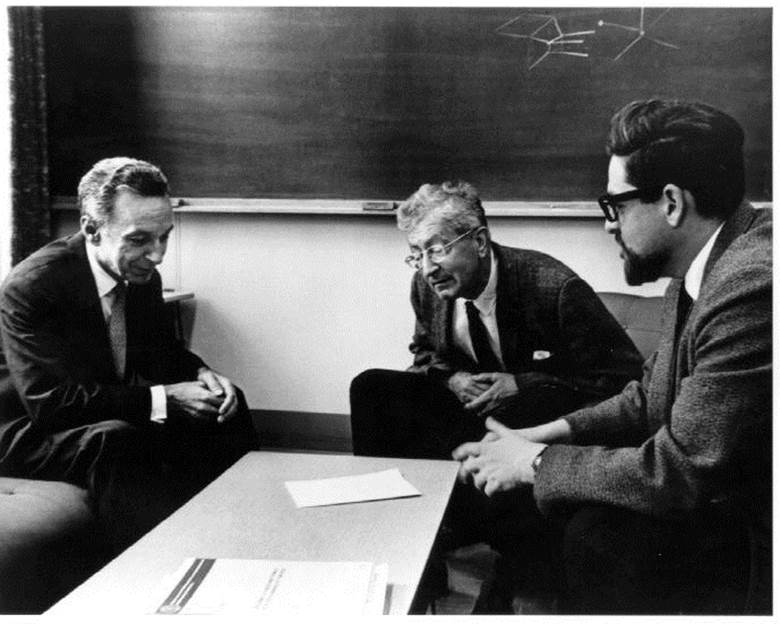 Eleazer Bromberg, James J. Stoker, and Louis Nirenberg (1960s).Photo Credit : Courant Institute, NYU.
Eleazer Bromberg, James J. Stoker, and Louis Nirenberg (1960s).Photo Credit : Courant Institute, NYU. -
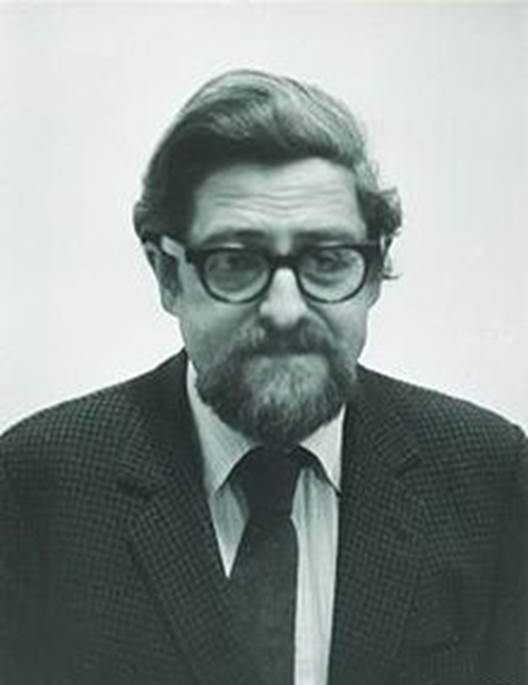 Louis Nirenberg.Photo Credit : Oberwolfach Photo Collection
Louis Nirenberg.Photo Credit : Oberwolfach Photo Collection
Louis Nirenberg
Canadian mathematician Louis Nirenberg is considered one of the greatest theoretical analysts of the 20th century, having made singular contributions to the field of linear and nonlinear partial differential equations (PDEs).
Nirenberg was born in Hamilton, Ontario, but his family soon moved to Montreal to join the larger Jewish community. He attended Baron Byng High School and then earned his undergraduate degree from McGill University, where he studied math and physics. After graduating, he joined the National Research Council of Canada, and worked on the Manhattan Project. In 1949, he obtained his doctorate from New York University (NYU), leading to a Professorship at NYU’s Courant Institute of Mathematical Sciences.
Within the field of linear and nonlinear partial differential equations (PDEs), Nirenberg’s contributions include the Gagliardo–Nirenberg interpolation inequality, an essential discovery in the solution of the elliptic partial differential equations, which affect many areas of mathematics; he also contributed to the formalization of a new mathematical concept known as John–Nirenberg space, which is used to study the behavior of martingales: elastic materials and games of chance. He was also instrumental in solving one of the biggest problems in physics, the Navier–Stokes existence and smoothness problem of fluid mechanics and turbulence. His co-authored paper on solutions to the Navier–Stokes equations was honoured by the American Mathematical Society with its 2014 Steele Prize for Seminal Contribution to Research.
Among Nirenberg’s numerous awards are the Bocher Prize for the American Mathematical Society (1959), the Crafoord Prize (1982), the Steele Prize for Lifetime Achievement from the American Mathematical Society (1994), the National Medal of Science (1995), the first-ever Chern Medal for lifetime achievement by the International Mathematical Union and the Chern Medal Foundation (2010), and the Abel Prize from the Norwegian Academy of Science and Letters (2015).
Learn More:
http://www.baronbynghighschool.ca/alumni/louis-nirenberg/
http://www.mat.ucm.es/~ln06/nirenberg/interview.pdf

-
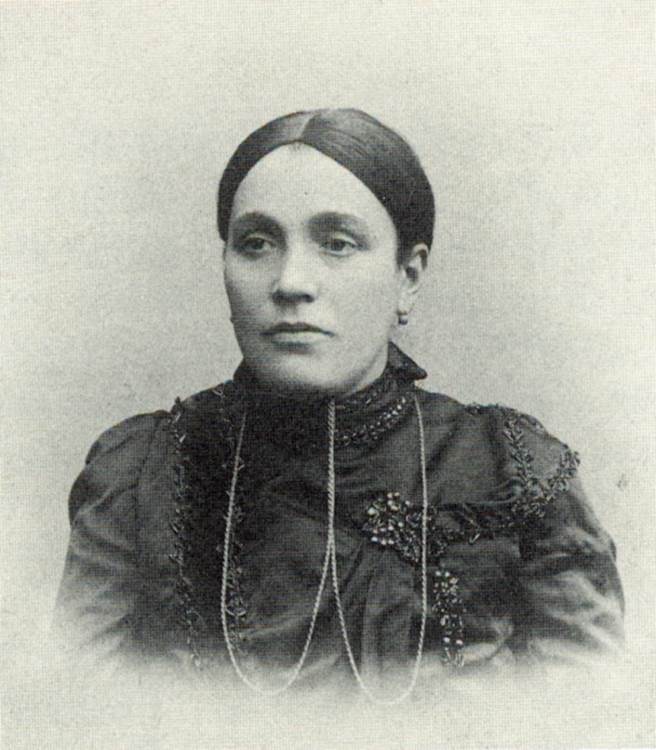 A portrait circa 1910 of Taube Kaplan – reproduced from the Montreal Clinical Society history souvenir book.Photo Credit : Alex Dworkin Canadian Jewish Archives
A portrait circa 1910 of Taube Kaplan – reproduced from the Montreal Clinical Society history souvenir book.Photo Credit : Alex Dworkin Canadian Jewish Archives -
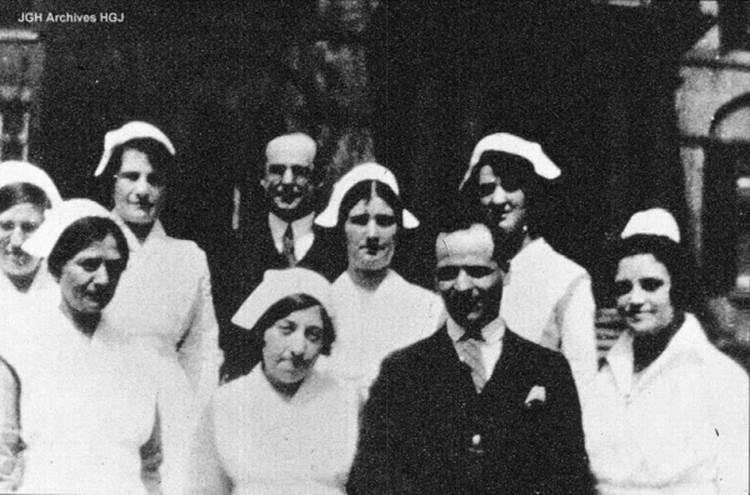 Nurses and doctors outside of the Hebrew Maternity Hospital in 1925 which offered obstetrics to Jewish and non-Jewish women. It was a precursor, along with the Herzl Dispensary, to the Jewish General Hospital and was founded in large part through the efforts of Taube Kaplan. It was located on Cadieux Street (now de Bullion St.).Photo Credit : © JGH Archives HGJ
Nurses and doctors outside of the Hebrew Maternity Hospital in 1925 which offered obstetrics to Jewish and non-Jewish women. It was a precursor, along with the Herzl Dispensary, to the Jewish General Hospital and was founded in large part through the efforts of Taube Kaplan. It was located on Cadieux Street (now de Bullion St.).Photo Credit : © JGH Archives HGJ -
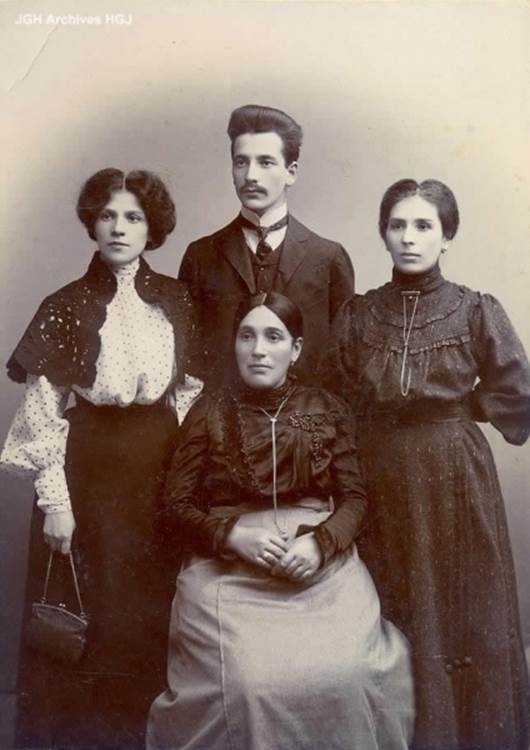 Taube Kaplan pictured with three of her children in Vilnius. From left to right: Mrs. Rachel Bach, Mr. Ben Wiseman, Mrs. Anna Arons. Seated: Mrs. Taube Kaplan.Photo Credit : © JGH Archives HGJ
Taube Kaplan pictured with three of her children in Vilnius. From left to right: Mrs. Rachel Bach, Mr. Ben Wiseman, Mrs. Anna Arons. Seated: Mrs. Taube Kaplan.Photo Credit : © JGH Archives HGJ -
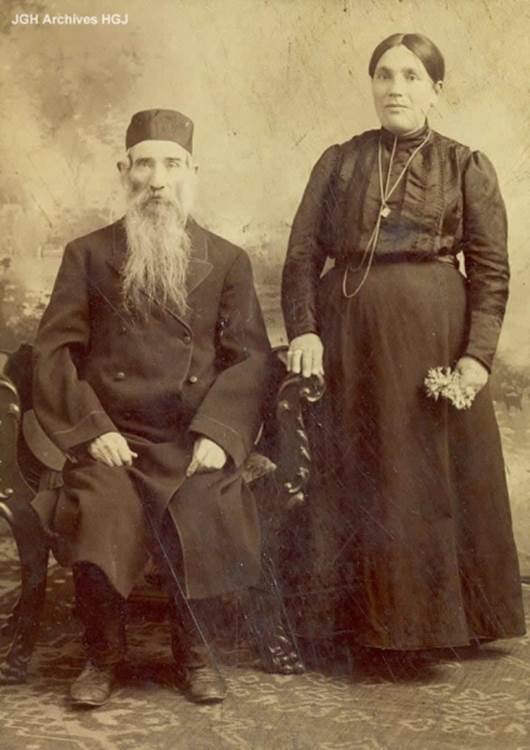 Taube Kaplan and her husband Rabbi Jacob Kaplan. Photograph taken in the photography studio of Marcus Baum on 443 St. Lawrence, Montreal.Photo Credit : © JGH Archives HGJ
Taube Kaplan and her husband Rabbi Jacob Kaplan. Photograph taken in the photography studio of Marcus Baum on 443 St. Lawrence, Montreal.Photo Credit : © JGH Archives HGJ
Taube Kaplan
At a time when Montreal's infant mortality rate was one of the highest in the world, Taube Kaplan went door to door to collect the funds necessary for the creation of the first Jewish maternity hospital in Montreal.
In the 1910s, Montreal’s infant mortality rate was among the highest in the world: more than one in five children died before their first birthday. The situation was especially dire in the impoverished neighbourhoods that were home to many of the city’s Jewish immigrants. In 1914, Kaplan proposed the creation of a hospital providing prenatal and postpartum care for young Jewish women. In response to the massive immigration of mostly destitute Eastern European Jews, Kaplan sought to provide services for mothers otherwise unable to afford it. The hospital was created specifically for Jewish women, and served kosher food.
Kaplan achieved a feat that would be almost unthinkable today, canvassing door-to-door for years to raise funds for the construction of the Montreal Hebrew Maternity Hospital. The individual donations she collected financed the purchase of a building on Cadieux Street (today Rue De Bullion), to be turned into a hospital. With the support of several influential individuals, among them a group of physicians headed by Dr. J. R. Goodall, the project was completed in 1916.
Kaplan was a pioneer in the area of Jewish hospital services at a time when none were available in Montreal. Her actions led to the creation of a precursor institution to the Jewish General Hospital. She also played an important role with regard to the position of Jewish women in society. While women in general were only just beginning to become involved in public matters and institutions, such participation was even less common in Kaplan’s Orthodox community. A woman of modest origins who taught Hebrew and religion several hours a week to supplement her husband’s meagre income, Kaplan consistently refused recognition for her efforts. This led her to decline the honour of having a ward named after her in the future Montreal Jewish General Hospital.
Special thanks to the Museum of Jewish Montreal.
Learn More:
http://imjm.ca/location/2152
http://mimj.ca/location/2160
http://jgh.ca/documents/91/1_poster.pdf

-
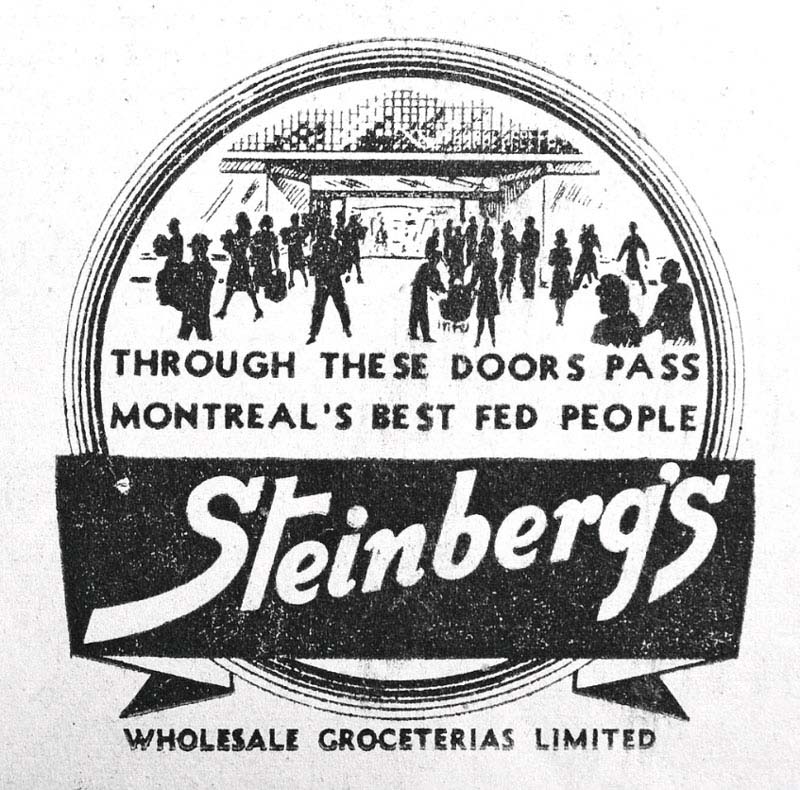 Steinberg’s ad, 1949.Photo Credit : Vintage Canadian Supermarkets
Steinberg’s ad, 1949.Photo Credit : Vintage Canadian Supermarkets -
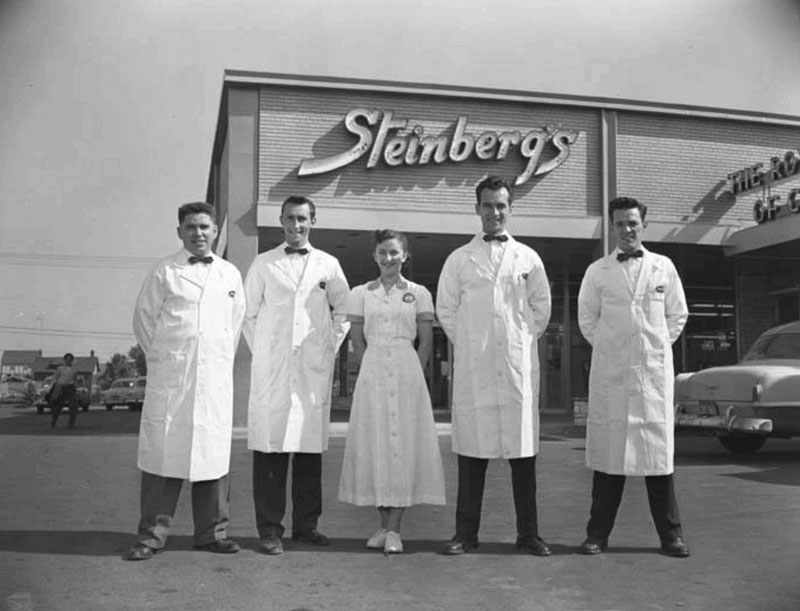 Employees in front of Steinberg’s supermarket, 1955.Photo Credit : Vintage Canadian Supermarkets
Employees in front of Steinberg’s supermarket, 1955.Photo Credit : Vintage Canadian Supermarkets -
 Steinberg Supermarket in Loretteville, Québec (1979).Photo Credit : Steinberg Museum
Steinberg Supermarket in Loretteville, Québec (1979).Photo Credit : Steinberg Museum -
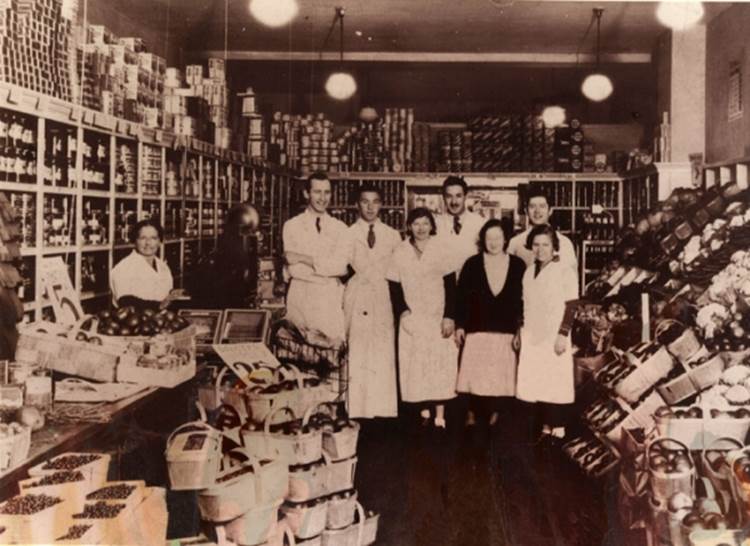 Early photograph of the interior of Steinberg grocery store. Group portrait with employees, Ida Steinberg (behind cash). ca. 1920s.Photo Credit : Jewish Public Library - Archives
Early photograph of the interior of Steinberg grocery store. Group portrait with employees, Ida Steinberg (behind cash). ca. 1920s.Photo Credit : Jewish Public Library - Archives -
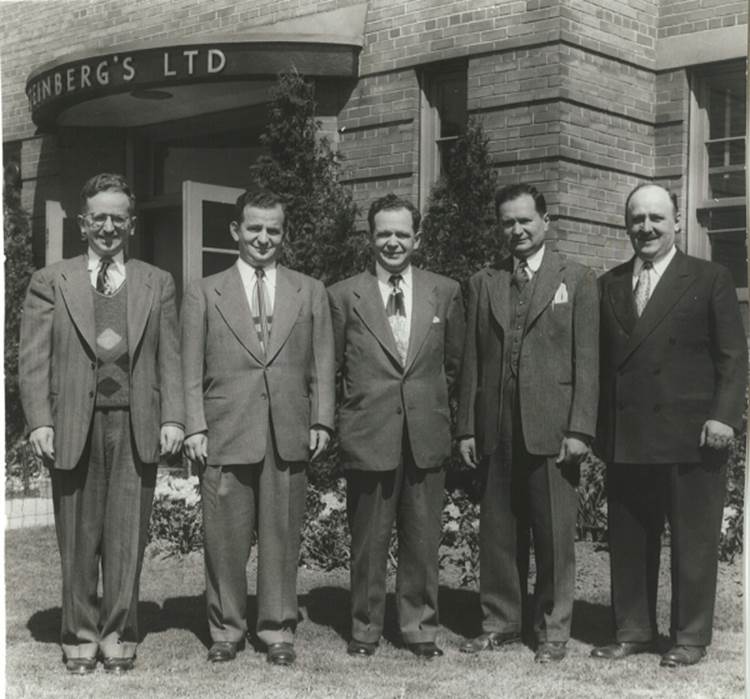 Exterior of Steinberg's Limited. Group Portrait, Nathan Steinberg, Jack Steinberg, Sam Steinberg, Max Steinberg, Morris Steinberg. ca. 1950s.Photo Credit : Jewish Public Library - Archives
Exterior of Steinberg's Limited. Group Portrait, Nathan Steinberg, Jack Steinberg, Sam Steinberg, Max Steinberg, Morris Steinberg. ca. 1950s.Photo Credit : Jewish Public Library - Archives
Steinberg’s
Samuel Steinberg was a Hungarian-born Canadian businessman and philanthropist whose drive and vision transformed his mother’s unassuming grocery store, Steinberg’s Supermarket, into the largest grocery chain in Quebec.
Steinberg moved to Canada as a child and worked, along with his four brothers, at Steinberg’s Supermarket. Through mass merchandising, industrial mechanization of food production and employee management, he transformed the world of food retailing in Quebec. And by the late 1950s, his stores had expanded into Ontario. For several decades, Steinberg’s was the largest supermarket chain in all of Quebec, running in close competition with stores like Provigo and Metro. Steinberg was also a director of Ivanhoe and Pharmaprix.
Steinberg was one of the first employers to implement mandatory bilingualism (English and French) for all his employees. As result, the supermarket became a meeting point for the Montreal Jewish community and their Quebecois neighbours. Among Francophones, “Je fais mon Steinberg” (“I’m doing my Steinberg’s”), came to be synonymous with the act of grocery shopping, regardless of the supermarket chain. In 1974, Steinberg became a local celebrity, when he was the subject of the National Film Board of Canada documentary, After Mr. Sam. At the time of his death, the company was annually grossing over $1 billion, was the largest supermarket chain in Quebec, and was completely family-owned.
Steinberg and his wife Helen (née Roth) were generous donors who funded a number of philanthropic causes including The Pavilion of Judaism at Expo 67, the Helen and Sam Steinberg Foundation’s Geriatric Day Hospital, and the Sam Steinberg Award for Young Jewish Entrepreneur of the Year, awarded by the Jewish Chamber of Commerce of Montreal. Steinberg also served as Chairman of the Board of Governors of the Canada-Israel Chamber of Commerce, as a member of the Canada Council and as National Director and Co‑Chairman of the Canadian Council of Christians and Jews. For his contributions to Canadian society and its economy, Steinberg was made an Officer of the Order of Canada and inducted into the Canadian Business Hall of Fame.
Learn More:
https://en.wikipedia.org/wiki/Sam_Steinberg
http://www.nfb.ca/film/after_mr_sam/
http://www.thecanadianencyclopedia.com/en/article/samuel-steinberg/
http://www.jgh.ca/en/BioSteinberg
https://www.flickr.com/photos/ghost_of_steinbergs/with/25282954574/

-
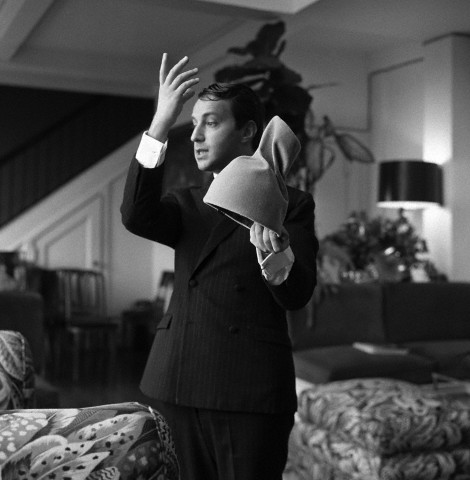 Arnold Scaasi, 1965.Photo Credit : © Condé Nast Archive/Corbis
Arnold Scaasi, 1965.Photo Credit : © Condé Nast Archive/Corbis -
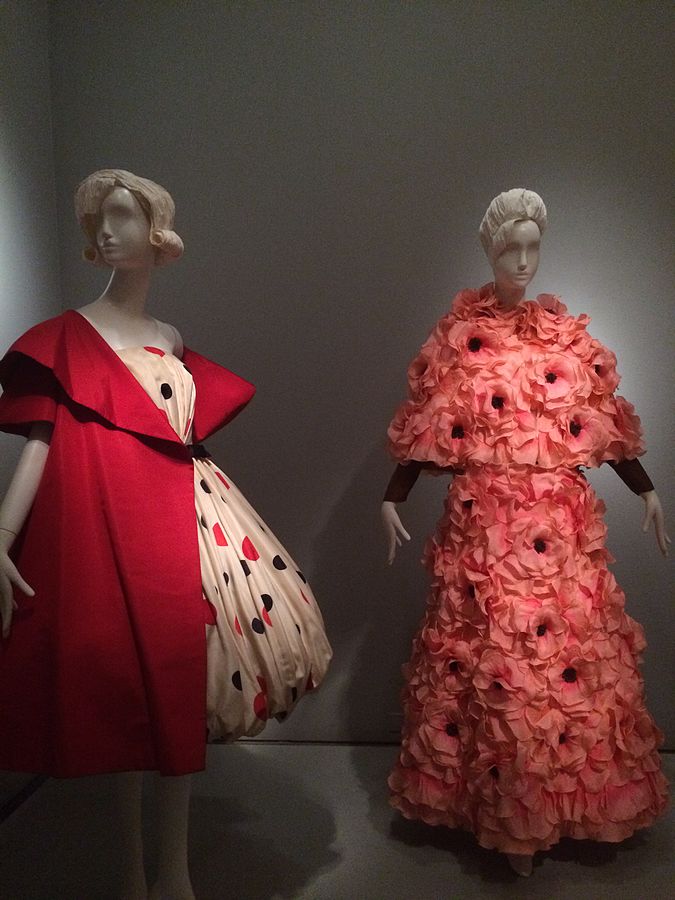 Some of Arnold Scaasi's designs.Photo Credit : Brooklyn Museum Costume Collection at The Metropolitan Museum of Art
Some of Arnold Scaasi's designs.Photo Credit : Brooklyn Museum Costume Collection at The Metropolitan Museum of Art
Arnold Scaasi
Arnold Scaasi was a legendary Montreal-born fashion designer who created iconic gowns for first ladies, movie stars and socialites, including Barbara Streisand, Hillary Clinton, Princess Yasmin Aga Khan and Elizabeth Taylor.
Scaasi was born Arnold Isaacs, to an immigrant Jewish family in Montreal. He was introduced to fashion at a young age because his father was a furrier. His formal study of fashion took place first at Montreal’s Cotnoir-Capponi School of Design and then at the Syndical Chamber for Haute Couture in Paris. Scaasi moved to New York City soon afterward, where he worked with designer Charles James.
He was encouraged to change his name (Scaasi is Isaacs backward) by interior designer Robert Denning (originally Robert Dennis Besser), who said it would give him an Italian flair. With this new moniker, Scaasi quickly rose to prominence as a fashion designer, one of his dresses making the cover of Vogue in 1955. In 1964, he opened his own couture house in New York City, attracting socialites and celebrities. His signature looks were cocktail dresses (incorporating fur, feathers, sequins, embroidery), tailored suits and glamorous evening wear. When Barbara Streisand wore Scaasi’s sheer, sequined pant suit to the Academy Awards the year she won for Funny Girl, the designer was propelled to international stardom.
Scaasi’s most memorable designs are held in museum collections and couture houses around the world, including the Smithsonian Institution and the New York Historical Society. They have also been featured in retrospectives at venues including Kent State University, Ohio University and the Fashion Institute of Technology. He authored two books: Scaasi: A Cut Above and Women I Have Dressed (and Undressed!).
In 1996, Scaasi received the Council of Fashion Designers of America Lifetime Achievement Award.
Learn More:
https://www.youtube.com/watch?v=-eE3HpBk0Ec
https://www.youtube.com/watch?v=3RKT_InAzuE
http://www.cnn.com/2015/08/04/fashion/new-york-arnold-scaasi-death/
http://www.instyle.com/news/arnold-scaasi-dies-85
http://nymag.com/thecut/2015/08/arnold-scaasi-put-an-american-stamp-on-couture.html#

-
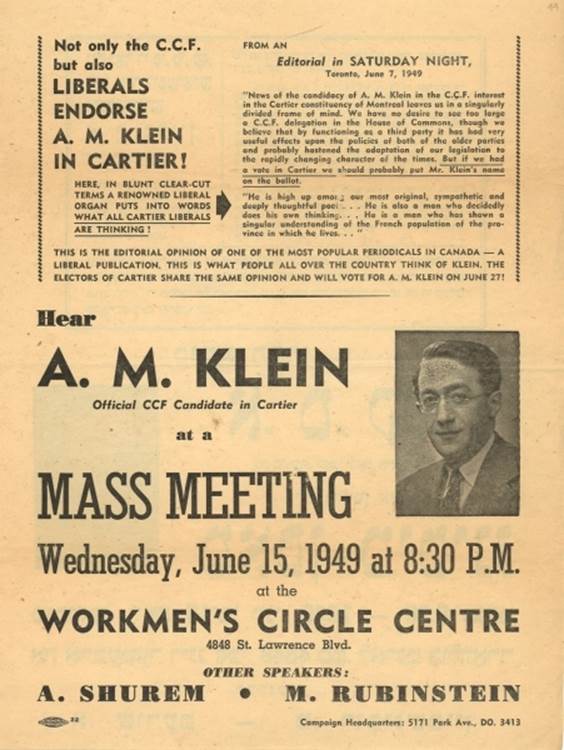 Flyer for a mass meeting supporting A. M. Klein's federal election campaign, at the Workmen's Circle Centre, June 15, 1949Photo Credit : Alex Dworkin Canadian Jewish Archives
Flyer for a mass meeting supporting A. M. Klein's federal election campaign, at the Workmen's Circle Centre, June 15, 1949Photo Credit : Alex Dworkin Canadian Jewish Archives -
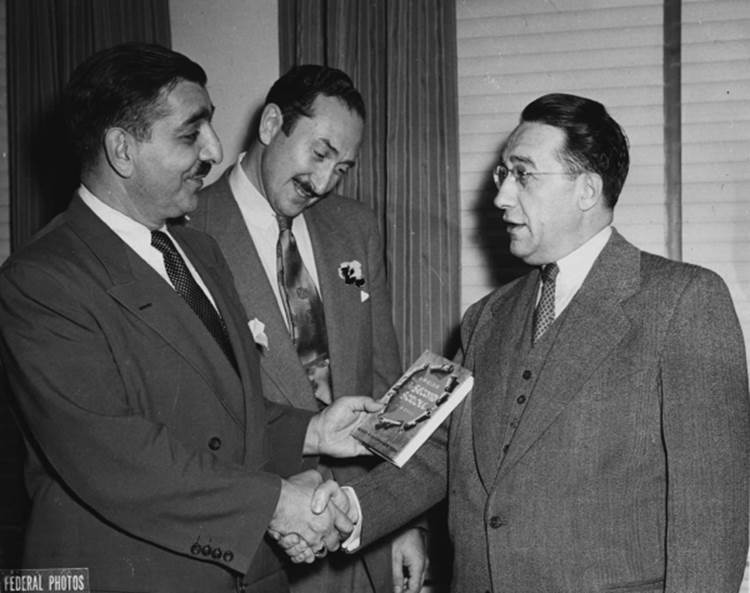 A. M. Klein (right) presenting Monroe Abbey (left) a copy of his book, The Second Scroll, ca. 1951.Photo Credit : Alex Dworkin Canadian Jewish Archives
A. M. Klein (right) presenting Monroe Abbey (left) a copy of his book, The Second Scroll, ca. 1951.Photo Credit : Alex Dworkin Canadian Jewish Archives -
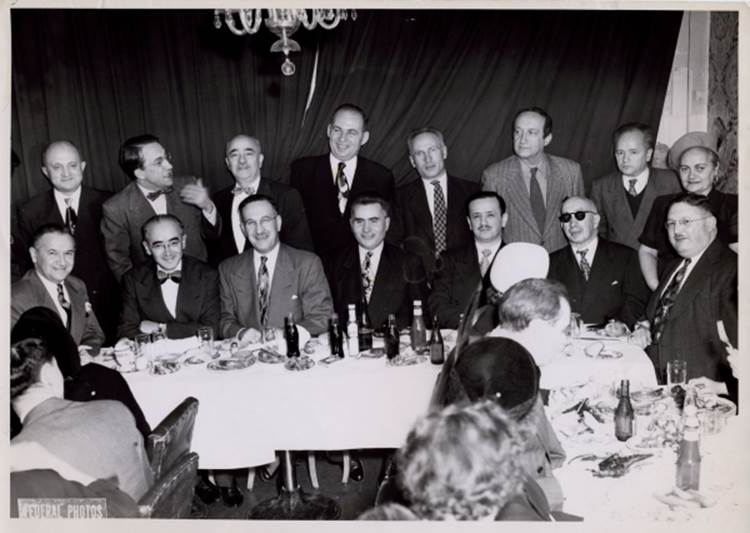 A meeting of many Jewish literary figures from Montreal who wrote in Yiddish or English (or both) including Israel Rabinovitch (Keneder Adler editor), A. M. Klein (poet), Mordechai Ginzburg (Yiddish journalist) and Jacob Isaac Segal (journalist and Yiddish poet), ca. 1950s.Photo Credit : Jewish Public Library - Archives
A meeting of many Jewish literary figures from Montreal who wrote in Yiddish or English (or both) including Israel Rabinovitch (Keneder Adler editor), A. M. Klein (poet), Mordechai Ginzburg (Yiddish journalist) and Jacob Isaac Segal (journalist and Yiddish poet), ca. 1950s.Photo Credit : Jewish Public Library - Archives -
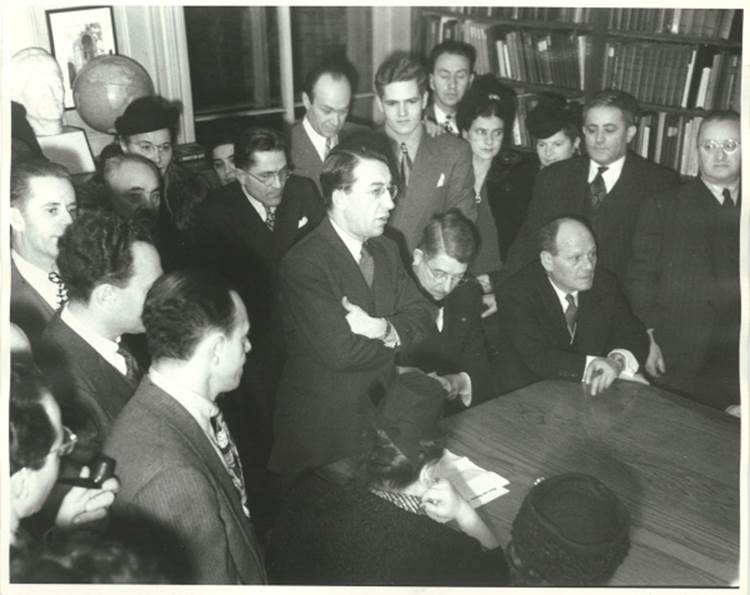 Group portrait, including Maurice Hartt (at that time a Member of the Legislative Assembly of Quebec, later a federal MP), Pierre Van Paasen, Michael Becker, and A. M. Klein, upon the occasion of the visit of Pierre Van Paasen (a Dutch-Canadian journalist who supported Zionism) to the Jewish Public Library, November 25, 1945. Standing centre is A. M. KleinPhoto Credit : Jewish Public Library - Archives
Group portrait, including Maurice Hartt (at that time a Member of the Legislative Assembly of Quebec, later a federal MP), Pierre Van Paasen, Michael Becker, and A. M. Klein, upon the occasion of the visit of Pierre Van Paasen (a Dutch-Canadian journalist who supported Zionism) to the Jewish Public Library, November 25, 1945. Standing centre is A. M. KleinPhoto Credit : Jewish Public Library - Archives
A. M. Klein
A. M. Klein was a leading Canadian poet (as well as journalist, novelist, short story writer and lawyer), in whose memory the A.M. Klein Prize for Poetry was created by the Quebec Writers' Federation.
Born in Ratno, Ukraine in 1909, Klein immigrated to Montreal with his family in 1910. His Orthodox father wanted his son to become a rabbi and greatly influenced Klein’s early formation in rabbinic literature. Klein attended Baron Byng High School, and then McGill, where he studied political science, classics and economics, befriending a circle of poets and critics. There, he co-founded the McGilliad literary journal in 1930.
After completing his law degree at l’Université de Montréal, he joined a firm, even as his interest in literature grew. He wrote many poems in the 1920s and 30s on Jewish themes. Fluent in French, Klein understood the challenges and nuances of French Canadian politics, which made him a unique figure in the English-speaking Jewish community, as well as in most of English Canada. In 1948, Klein published The Rocking Chair, a series of poems about Quebec’s Francophone culture, using Montreal locations as sources of inspiration and establishing parallels between French Canadian and Jewish culture. He respected the Quebecois concern over culture, and opened up French Canada to many Anglophones through his poetry and writings. This collection won him a Governor General’s Award.
In 1949, Klein travelled to the newly established nation of Israel, as well as to Europe and Morocco. Articles about his experiences, entitled Notebook of a Journey, were published in the Canadian Jewish Chronicle, and went on to influence his only novel, The Second Scroll. Published in 1951, the book challenged the accepted boundaries of the Canadian novel, dealing with autobiographical themes as well as the Holocaust and the founding of Israel.
Klein was also an active member of the Montreal Jewish community. He served as editor of the Canadian Jewish Chronicle from 1932 until 1955 and was a consultant and speechwriter to Samuel Bronfman. In 1949, Klein ran unsuccessfully for the Canadian Parliament as a representative of the Co-operative Commonwealth Federation (the forerunner of the NDP). In 1956, he was awarded the Lorne Pierce Medal by the Royal Society of Canada. Despite the success of his writing, Klein suffered a nervous breakdown, ceased writing, and withdrew from public life by 1955.

